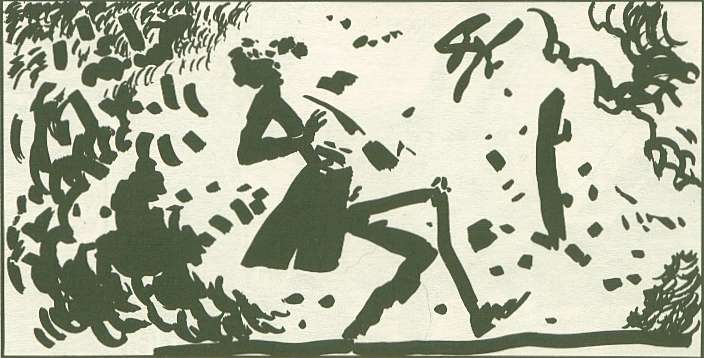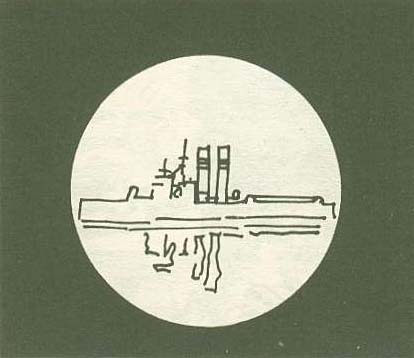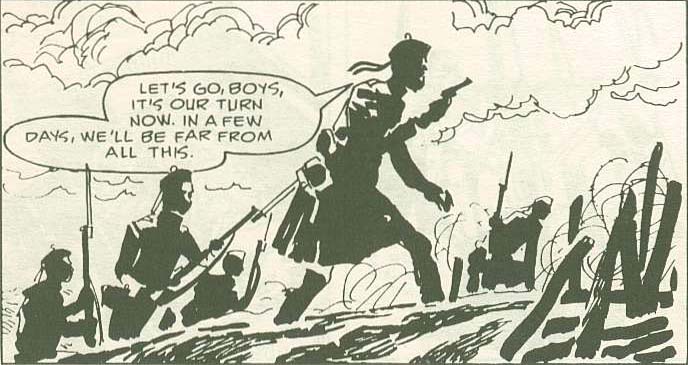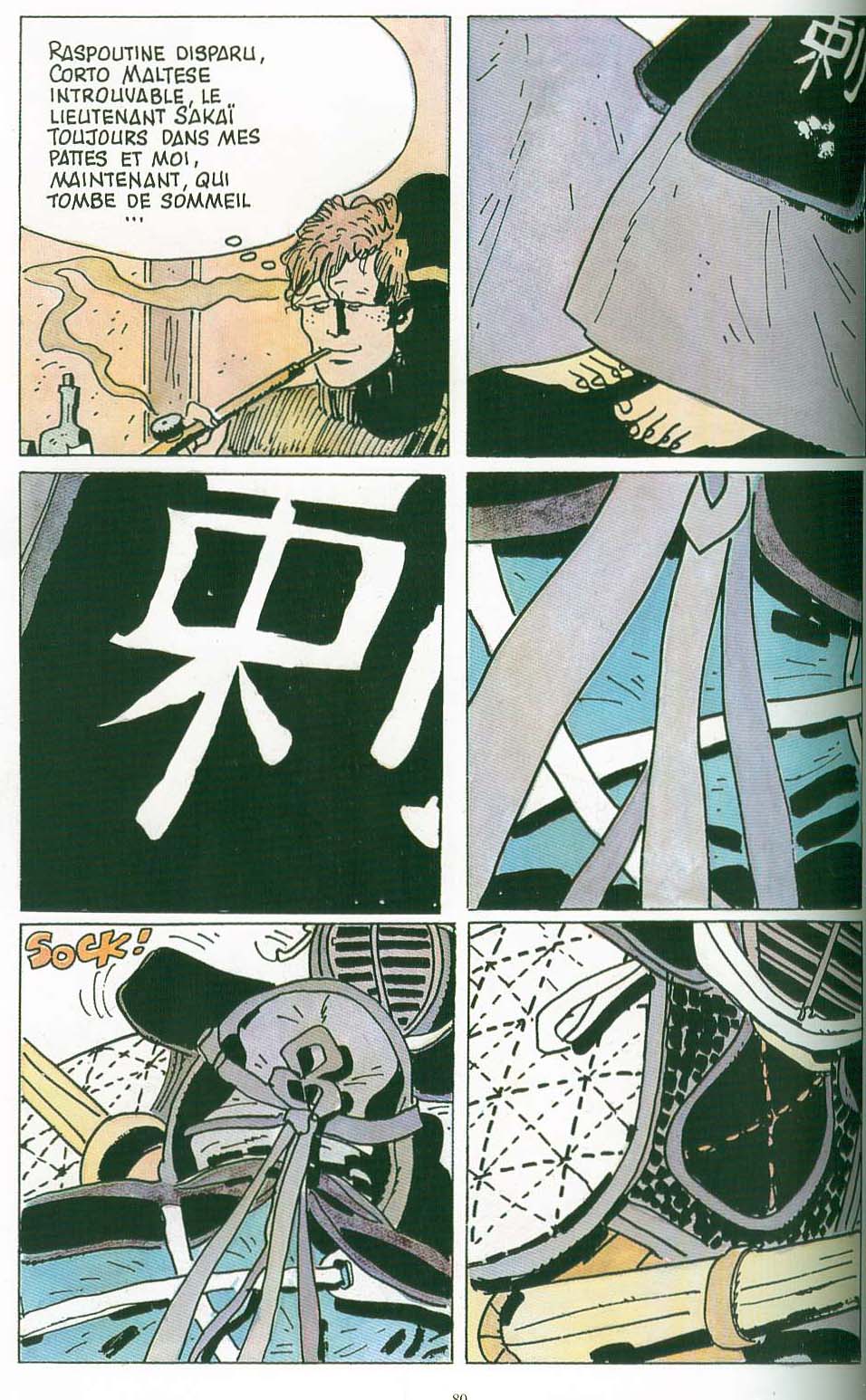Hugo Pratt is one of those names that you can use to separate the knowledgeable from the unlearned when it comes to European comics. Those that know recognize the name immediately; not knowing him is like not knowing Kirby.

His most famous creation is Corto Maltese, a name that should be familiar to anyone who’s read The Dark Knight Returns – it’s used as the name of the small island nation where Superman is forced to intervene. Frank Miller is an avid Hugo Pratt devotee and provided the introduction for the English translation of Book 3 in the series that NBM published in the mid-80s. Pratt’s extreme use of solid blacks and whites in high contrast for effect had a direct impact on Frank Miller, especially in Sin City.


In fact, many feel that Pratt’s linework is of more interest than the character he created, which is understandable. It’s obvious that Pratt put an enormous effort into creating believable tableaux, drawing from his life experience as a world-traveler to add a layer of verisimilitude to his creations. However, his best work is not the buildings and costumes that he creates, but those occasions where he finds it necessary to step back and provide a more impressionistic view of things – usually during action sequences.

The confident use of rough blacks, shadow effects and precise linework in concert is really what makes Hugo Pratt such an interesting artist. It’s nearly impossible to flip through his books without wanting to stop and examine the linework. From there, it’s a short lack of impulse control away from figuring out where the story starts and finding out what’s going on in the story at hand.

NBM released eight books in translation, but the whole run has been out of print for decades. Mostly because of the quality of the art, the books are very difficult to find and are an occasion for rejoicing when they turn up.
When I was at HeroesCon in 2010, I ran across a vendor who had a pair of the NBM books on his shelf. These books are very rare and can fetch quite a bit of money on eBay from sellers who know exactly what they have on their hands. The fact that I paid as little for these books as I did makes me want to go back to that reseller. In fact, I had my eye on his collected Terry and the Pirates reprints as well…

To me, the appeal of the Corto Maltese stories has always been the rich history of the character and the way that creator Hugo Pratt integrated him into the events of the day. From his (chronologically) first appearances in the Russo-Japanese war, where he meets the war correspondent Jack London and his long-time adversary Rasputin, the Maltese stories show him wandering the globe for over twenty years, visiting most of the continents and just generally being “a gentleman of fortune.”
Each NBM book collects a series of four or five 20 page stories that were originally printed in the Pif gadget comics magazine – which is how Francophone comics were usually serialized. I picked up Books 2 & 3 (Banana Congo and Voodoo for the President) in Charlotte and I already owned Book 4 (A Midwinter Morning’s Dream). Read in order, the stories tie together in a loose but coherent fashion. One leads into another into another and the books are structured about right for the themes presented.

Banana Congo and Voodoo for the President are largely focused on Corto’s adventures in South America and the Caribbean, getting involved in political situations that he has no stake in, searching for treasure, encountering unusual characters and eventually running off to Venice to find part of a long-lost treasure map. The next book in the series is entirely set in Europe and the remains of World War I, although it does have a great interlude in Dublin.
One of the best stories in these books is about a group of soldiers from various armies who have banded together to liberate a cache of hidden gold in a small town that keeps changing hands with the vicissitudes of war. The story makes the point that only a neutral pirate like Corto Maltese could have possible organized all of these various parties together to make the plan work. It starts with an observation balloon going off-mission, but it turns into a fantastic caper.

There are several dream sequences throughout the stories, some of which are centered on Maltese and some of which aren’t. It takes a strong character to not be the center of his own stories, which Maltese frequently isn’t. In the Russo-Japanese war story, he doesn’t show up until almost two-thirds of the way through the narrative! (Mind you, that story was written well after the character was established, in an attempt to give some more backstory to an already colorful individual.)
At one point, Maltese loses his memory. In the very next story, his traveling companion decides that the best way to give Maltese his memory back is to feed him magic mushrooms obtained from a tribe in the central Amazon rain forest. Predictably, this leads to yet another dream sequence.
As a treasure-seeker, rogue and anti-hero, Corto Maltese is much more world-weary than Han Solo or Indiana Jones and should really be placed in their company as a default go-to character archetype for comics readers. The wikipedia page about the character points out that Maltese frequently shows up in various other European comics – not always by name, but usually recognizable by appearance alone.
The French publisher Casterman has re-released the entire Corto Maltese library in chronological order of occurrence (which is not the same as the publication order). These handsome, hardback books also contain a little essay at the front, talking about Pratt’s artistic influences and the time period of the story – or so I imagine; I haven’t actually gotten around to translating that bit of French yet. The Casterman books are also notable for being in color, which is unusual because the originals (and NBM translations) were printed in black and white.

The colors do not actively detract from the impact of the linework, but the black and white pages really show off Pratt’s compositional abilities at a macro level to much better effect. I will say, however, that the page just before Corto’s introduction in La Jeunesse (which I picked up in Brussels) is almost an abstract comic. The individual panels are really just snapshots of action, flashes of color that capture our attention.
When I originally started reading La Jeunesse, I was using the one-word-at-a-time method with a dictionary and only got about halfway through the story. After reading Books 2 & 3, though, I went back and realized that Pratt’s storytelling style was not all that complicated. With a little bit of squinting, I was able to get through the rest of the book using only my casual understanding of French. I should have known to do that from the fact that I was able to read the introductory page from La Jeunesse without any translation assistance at all.

Reading the book in French, however, did highlight the fact that the letters of the alphabet have evolved from pictographs and are, essentially, nothing more than standardized drawings. When those letters form patterns that are recognizable as words that I understand, I see them as text. When they form words that I do not immediately recognize, their evolutionary past is much more obvious and they become just another kind of organized pattern of marks on the page.
There are occasional rumors that one company or another is going to publish the Corto Maltese books in English, but nothing ever comes of them. For that reason, those readers who are serious about Hugo Pratt and his most famous character will probably have to deal with the language barrier and read the series in French. Considering the volume of additional material that comes with French, I’d say that it’s not a bad way to go.
However, if you happen to find a copy of any of the NBM albums when you’re poking around in dusty bookstores, pick it up immediately. If you pay less than $30 for it, you got a bargain. If you find a copy of The Ballad of the Salt Sea, let me know.
1 throught on "Hugo Pratt’s Corto Maltese"